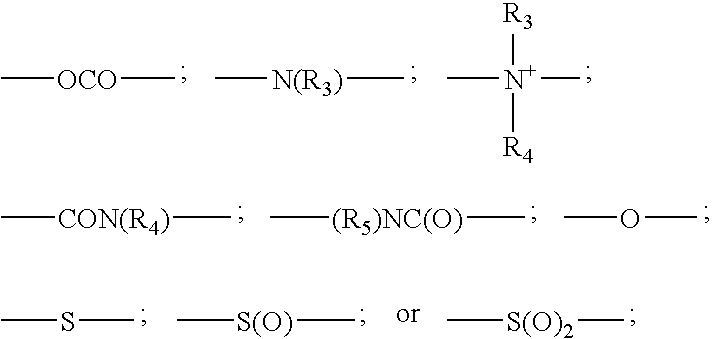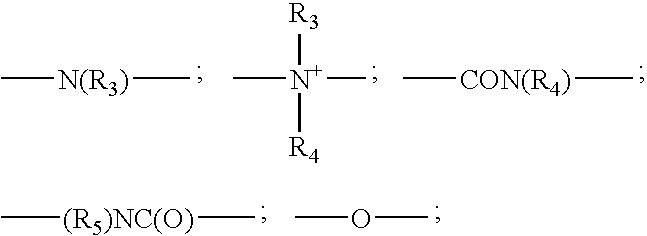Disulfide dyes, composition comprising them and method of dyeing hair
a technology of disulfide dyes and dyes, applied in the field of disulfide dyes, can solve the problems of unsatisfactory fastness of washing, and achieve the effect of good fastness
- Summary
- Abstract
- Description
- Claims
- Application Information
AI Technical Summary
Benefits of technology
Problems solved by technology
Method used
Image
Examples
examples a
Process of Preparation
EXAMPLE A1
[0330]
[0331]12.4 g 4-fluoroaniline are added to a stirred solution of 25 ml water and 25 ml of 32% hydrochloric acid at 295 K. The reaction mixture is cooled to 273 K and 19 ml of a 36% sodium nitrite solution are dropped at such a rate that the temperature of the mixture is maintained in the range of 273 to 276 K. After the addition of the sodium nitrite solution the mixture is stirred for one hour. If no excess of nitrite is detected during one hour (detection by using a potassium iodide paper) further sodium nitrite solution is added. The remaining excess of nitrite is reduced with sulfamic acid. The obtained diazo solution is dropped to a 273 K cold solution of 7.4 g imidazole in 30 ml water, whereby the pH of the solution is maintained in the range of pH 10 to 11 by adding 36% of a sodium hydroxide solution. After completing the diazo addition the obtained suspension is warmed up to 295 K, the pH is adjusted to 10.5 with 36% sodium hydroxide solu...
example a2
[0339]
12.4 g 2-fluoroaniline are added to a stirred solution of 25 ml water and 25 ml of 32% hydrochloric acid at 295 K. The reaction mixture is cooled to 273 K and 19 ml 36% sodium nitrite solution are dropped at such a rate that the temperature of the mixture is maintained in the range of 273 to 276 K. After the addition of the sodium nitrite solution the mixture is stirred for one hour. If no excess of nitrite is detected during one hour (detection by using a potassium iodide / starch paper) further amounts of sodium nitrite solution are added. Then the remaining excess of nitrite is destroyed with sulfamic acid. The obtained diazo solution is dropped to a 273 K cold solution of 7.4 g imidazole in 30 ml water, whereby the pH of the solution is maintained in the range of pH 10 to 11 by adding 36% sodium hydroxide solution. After completing the diazo addition the obtained suspension is warmed up to 295 K and the pH is adjusted to 10.5 with 36% sodium hydroxide solution. After stirrin...
example a3
[0347]
[0348]100 g 4-fluoro-3nitroanilin are added to a stirred mass of 80 g methanol and heated to 333 K. 0.1 ml sulfuric acid and 90 ml of acetic anhydride are added during 15 minutes. Heating and boiling are continued for 15 minutes. Then the reaction mixture is cooled slowly to 273 K with stirring. At the final temperature stirring is continued for 30, minutes, then the suspension is filtered off, washed with cold methanol, dryed in the vacuum dryer getting 114 g acetyl derivative which is worked up further. The acetyl derivative is solved in 520 ml ethanol and continuously added to 130 g iron in 35 ml concentrated hydrochloric acid and 220 ml water at 363K during 1 hour. The temperature drops to 353 K. The reaction mixture is stirred for further 3 hours. The hot mass is separated through filtration the residue washed with 100 ml ethanol. The filtrate and wash solution are cooled to 380 K with mixing, when crystallization of the product takes place. The product is separated by fi...
PUM
| Property | Measurement | Unit |
|---|---|---|
| Time | aaaaa | aaaaa |
| Fraction | aaaaa | aaaaa |
| Fraction | aaaaa | aaaaa |
Abstract
Description
Claims
Application Information
 Login to View More
Login to View More - R&D
- Intellectual Property
- Life Sciences
- Materials
- Tech Scout
- Unparalleled Data Quality
- Higher Quality Content
- 60% Fewer Hallucinations
Browse by: Latest US Patents, China's latest patents, Technical Efficacy Thesaurus, Application Domain, Technology Topic, Popular Technical Reports.
© 2025 PatSnap. All rights reserved.Legal|Privacy policy|Modern Slavery Act Transparency Statement|Sitemap|About US| Contact US: help@patsnap.com



